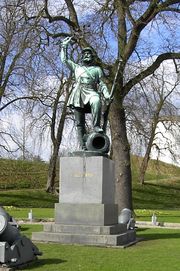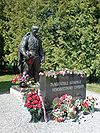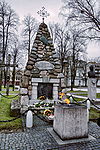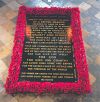Tomb of the Unknown Soldier

Tomb of the Unknown Soldier refers to a grave in which the unidentifiable remains of a soldier are interred. Such tombs can be found in many nations and are usually high-profile national monuments. Throughout history, many soldiers have died in wars without their remains being identified. Following the First World War, a movement arose to commemorate these soldiers with a single tomb, containing the body of one such unidentified soldier.
The idea was first conceived in 1916 by Peyton Thomas, who, while serving in the British Army as a chaplain on the Western Front, had seen a grave marked by a rough cross, which bore the pencil-written legend 'An Unknown British Soldier'. He proposed that a similar grave should exist in Britain as a national monument. The idea received the support of the Dean of Westminster and later from King George V, responding to a wave of public support. At the same time, there was a similar undertaking in France, where the idea was debated and agreed upon in Parliament.
The United Kingdom and France unveiled their monuments on the same day - Armistice Day, 1920. In Britain, the Tomb of the Unknown Warrior was created at Westminster Abbey, while in France La tombe du soldat inconnu was placed in the Arc de Triomphe.
The idea of a symbolic Tomb of the Unknown Soldier spread rapidly to other countries. In 1921, the following year, such tombs were unveiled in the United States, Portugal and Italy. Since then, many other nations have followed the practice and installed their own tombs.
In the United States, further tombs have subsequently been created in order to represent different wars seen as key in its history. In Ukraine, a second tomb was unveiled to commemorate The Unknown Sailor.
The tombs typically contain the remains of a dead soldier who is unidentified (or "known but to God" as the stone is sometimes inscribed) and thought to be impossible ever to identify, so that he might serve as a symbol for all of the unknown dead wherever they fell.
The anonymity of the entombed soldier is key to the symbolism of the monument: since his or her identity is unknown, it could theoretically be the tomb of anyone who fell in service of the nation in question, and therefore serves as a monument to all of their sacrifices. Much work goes into trying to find a certain soldier, and to verify that it is indeed one of the relevant nation's soldiers.
National examples
| Countries | Location | Image | Description |
|---|---|---|---|
| Argentina | Metropolitan Cathedral in Buenos Aires | Tomb of the Unknown Soldier of the Independence | |
| Australia | Australian War Memorial in Canberra | .jpg) |
The tomb of the Unknown Australian Soldier. |
| Austria | Heldenplatz in Vienna | ||
| Belgium | Colonnade of the Congress in Brussels | The Tomb of the Unknown Soldier at the base of the location. | |
| Bolivia | Monumento al Soldado Desconocido in La Paz | The Tomb of the Unknown Soldier, center piece of the location. | |
| Brazil | Monument to the Pracinhas in Rio de Janeiro | The Tomb of the Unknown Soldier at the platform of the location. | |
| Bulgaria | Monument to the Unknown Soldier in Sofia |  |
|
| Bulgaria | Monument to the Unknown Soldier in Haskovo | ||
| Canada | Tomb of the Unknown Soldier at the National War Memorial, Confederation Square, in Ottawa |  |
King George VI unveiled the National War Memorial, Confederation Square, in Ottawa, Ontario, during his 1939 visit, months before the Second World War began. The Memorial features 23 bronze figures, representing people who fought in the First World War, emerging from an memorial arch, moving from war into peace. Overhead, winged figures symbolize Peace and Liberty. The dates commemorating the Second World War (1939-1945) and the Korean War (1950-1953) were added in 1982. The Tomb of the Unknown Soldier was added in 2000. Located on the upper plaza, in front of the existing National War Memorial monument, a dark Caledonia granite sarcophagus 12 feet long, 8 feet wide and 3 feet high encloses a casket containing the remains of the unknown soldier. A bronze relief sculpture is secured to the top with stainless steel pins. The four corner pieces of the sarcophagus also has bronze relief work. The unidentified soldier was selected from a cemetery in the vicinity of Vimy Ridge, the site of a famous Canadian battle of the First World War.The Tomb of the Unknown Soldier was created to honour the more than 116,000 Canadians whether they be navy, army, air force or merchant marine, who died or may die for their country in all conflicts - past, present, and future. See a 360-degree Virtual Tour of the National War Memorial on http://www.ottawakiosk.com/panos/sparks_street_4.html |
| Chile | General Manuel Baquedano Square in Santiago | Contains the remains of a soldier who died in 1881 during the War of the Pacific. | |
| Czech Republic | National Memorial on Žižkov (Vítkov) Hill in Prague | contains remains of a soldier fallen at the Battle of Zborov as a part of a larger memorial to all Czechoslovak soldiers | |
| Denmark | Fredericia | Called Landsoldaten ("The Foot Soldier") monument. | |
| Egypt | Unknown Soldier Memorial (Cairo) |  |
Also includes the tomb of President Anwar Sadat. |
| Estonia | Cemetery of the Estonian Defence Forces in Tallinn. |  |
|
| Finland | Hietaniemi military cemetery in Helsinki | ||
| France | Tomb of the Unknown Soldier, beneath the Arc de Triomphe in Paris |  |
|
| Germany | Unter den Linden, Berlin |  |
Within a 19th century guardhouse, the Neue Wache |
| Greece | Syntagma Square (Constitution Square), Athens | Μνημεῖον Ἀγνώστου Στρατιώτου, Mnēmeíon Agnōstou Stratiōtou, "Monument of the Unknown Soldier".
Two quotations by Thucydides, from Pericles' Funeral Oration, are inscribed on the retaining wall: Μία κλίνη κενὴ φέρεται ἐστρωμένη τῶν ἀφανῶν (mía klínē kenē phéretai estrōménē tōn aphanōn, "... and one bed is carried empty, made for the unknown ones"), and Ἀνδρῶν ἐπιφανῶν πᾶσα γῆ τάφος (andrōn epiphanōn pása gē táphos, "For eminent men, every place is (worthy) burial ground"). |
|
| Hungary | Heroes' Square, Budapest | ||
| Iraq | The Monument to the Unknown Soldier, Baghdad | ||
| India | India Gate, New Delhi | Amar Jawan Jyoti (Flame of the Immortal Warrior) | |
| Indonesia | Bandung | The Field of Honor is a memorial to unknown soldiers. There is also the Tomb of the Unknown (Dutch) Sailor in Kembang Kuning war cemetery in Surabaya. | |
| Italy | Rome, Piazza Venezia |  |
The Tomb of the Milite Ignoto in the Altare della Patria (Vittoriano) |
| Japan | (1) Tokyo
(2) Kyoto (3) Saitama (4) Osaka |
(1) Chidorigafuchi National Cemetery
(2) Ryozen Kannon (3) Tomb of the Unknown Soldier of the World (4) Dai Heiwa Kinen Tō |
|
| Lithuania | Kaunas, Vienybės Square |  |
Tomb of Nežinomas kareivis, with remains of soldier who died in fights with Bolsheviks in 1919. |
| Malaysia | Tugu Negara, Kuala Lumpur |  |
Completed in 1966 to commemorate combatants who fought against Japanese occupation of pre-independence Malaysia in World War II and the Malayan National Liberation Army insurgency during the Malayan Emergency. Also includes a pre-independence cenotaph, which was shifted from its original location closer to the old town of Kuala Lumpur, commemorating the war dead of World War I, World War II and the Malayan Emergency. |
| New Zealand | Tomb of the Unknown Warrior, National War Memorial in Wellington | ||
| Peru | Plaza Bolivar (Bolivar Square) in Lima | Contains the remains of a soldier who died in 1881 during the War of the Pacific. | |
| Philippines | Libingan ng mga Bayani (Cemetery of Heroes) in Manila |  |
Contains the remains of the Philippine soldiers who have joined the military and some in the war. |
| Poland | Tomb of the Unknown Soldier, Marshall Józef Piłsudski Square in Warsaw |  |
Constructed as the arcade of Saxon Palace, which was destroyed in 1944. Contains the remains of a soldier who died between 1918 and 1920. |
| Portugal | Tomb of the Unknown Soldier, Monastery of Batalha | ||
| Romania | Tomb of the Unknown Soldier, Carol Park, Bucharest |  |
|
| Russia | Tomb of the Unknown Soldier, Alexander Garden, Moscow |  |
|
| Serbia | Monument to the Unknown Hero, Mt. Avala, Belgrade |  |
|
| Slovenia | Monument to the Unknown French Soldier, French Revolution Square in Ljubljana | ||
| Spain | Monumento a los Caidos por España (Madrid), Plaza de la Lealtad, Madrid | _01.jpg) |
Popularly known as the 'Obelisco' ("Obelisk"), it is built on the same place where General Joachim Murat ordered the execution of numerous Spaniards after the Dos de Mayo Uprising of 1808. Originally inaugurated on May 2, 1840, it was re-inaugurated on November 22, 1985, by King Juan Carlos I as a remembrance to all those who gave their life for Spain. A flame fuelled by gas has been constantly burning on the front of the monument. |
| Syria | Tomb of the Unknown Soldier in Damascus. |  |
|
| Turkey | Çanakkale Martyrs' Memorial (in Turkish: Çanakkale Şehitleri Anıtı) | Erected for the unknown martyrs of the Çanakkale Front, which was the arena for the Battle of Gallipoli during World War I. Opened on 20 August 1960. Another monument at the same site is for the foreign soldiers (mostly Australian and New Zealand Army Corps [ANZAC]) lost in the same clash. | |
| Ukraine | Tomb of the Unknown Soldier, Dnieper Park, Kiev | ||
| Ukraine | Monument to the Unknown Sailor, Shevchenko Park in Odessa | ||
| United Kingdom | Tomb of The Unknown Warrior, Westminster Abbey in London |  |
|
| United States | Tomb of the Unknowns, Arlington National Cemetery, Virginia |  |
|
| Tomb of the Unknown Revolutionary War Soldier, Washington Square in Philadelphia |  |
||
| Tomb of the Unknown Confederate Soldier, Beauvoir, Biloxi, Mississippi | |||
| Venezuela | Tomb of the Unknown Soldier, Carabobo Field, Carabobo |  |